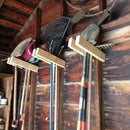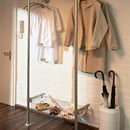Introduction: How to Build a Simple Handrail
Handrails are apart of our life. The government has made sure of that :-)
This is a simple hand rail that we built for our friend Bill to meet code. You might need something similar to meet a required building code or just for general safety purposes. I know there's a lot of discussion on this site about making things as cost effective as possible.. that's fine, just make sure it's safe. This handrail will exceed OSHA and BOCA requirements.
Please do not make this out of PVC ;-)
Step 1: Measure the Area
Before buying anything you need to do some measurements.
First we did a basic drawing of the area. This helps us keep our numbers straight. It doesn’t have to be anything fancy.
Mark where you want the posts to go. This will serve as a reference point.
We will then make the following measurements:
1. The height of the steps
2. The depth of the steps
3. The distance between the edge of the step and the post markers (offset)
Write all this information down on your drawing.. when you finish you should have something like the attached picture.
Step 2: Do Your Calculations
Now that we have our step dimensions we need to make some calculations to determine how much pipe and what type of fittings (we are using Kee Klamp fittings) we will need to complete this job.
d
Lets start with the simple and work our way to the complex
1. Posts – The posts at the top and the bottom need to be the same height. BOCA and OSHA standards specify that the minimum height of the handrail must be 42”. For simplicity that’s the length we are going to specify
2. Handrail – Calculating the length of the hand rail is a bit more complicated.
First we need to determine the angle.
- To do that we take the distance from post to post. Add the step length plus the length from the post to the step.
Then we determine the height of the steps.
- Add the step height together.
Determine the Angle
- Now here were you might need a calculator. In order to get the angle with the height and the length use the following equation. Divide the Height by the Length. Then do an Inverse Tangent on that number. That number should be the bottom angle of your handrail.
Selecting Angle Fittings
- Now that you have the angle you can determine the type of fitting that you want to use. Kee Klamp fittings offer a number of angled fittings.
- For our project because of the angles we’re going to be using a Type-C50 fittings at the top and at the bottom. They allow you to create a handrail at just about any angle.
C50 - https://www.simplifiedbuilding.com/pipe-fittings/kee-klamp/c50-single-swivel-socket
Now we are ready to determine the length of our handrail pipe.
- First we determine the overall length using the classic formula you learned in geometry a2 + b2 = c2. We just square the height and the length. Add them together. And take the square root of that number. That will give us the overall length.
- Now we’re not done. Because the fittings have some length to them we need to to a little math. There’s a handy chart in the Kee Klamp catalog (and on our website- https://www.simplifiedbuilding.com/kits/stair-railing-kits ) which gives us the numbers we need to subtract. There is no figure for the C50 (they do have offsets for other popular angle fittings) so we just figured an 1" on each side.
I threw together a spread sheet to do these calculations.. I left my numbers in it and attached it so that you can see where I'm coming from.
Selecting Flanges
- There are many different types of flanges to mount your handrail. We chose to use a simple Type 62 flange. We then used Tapcon concrete anchors to secure these to cement.
62 Flange - https://www.simplifiedbuilding.com/pipe-fittings/kee-klamp/62-standard-railing-flange
One more piece:
Because we’re using a Type C50 fitting we’ll need a Type 84 malleable plug. This will finish off the top pipe and make sure no water get’s inside.
84 Malleable Plug - https://www.simplifiedbuilding.com/pipe-fittings/kee-klamp/84-malleable-plug
Selecting Pipe:
When installing a handrail make sure that you use Schedule 40 PIPE (not tube or fence post).
When selecting pipe you want to make sure that the steel is galvanized. This will ensure that you handrail will not rust. You might also think about having your pipe powder coated to protect it.
Taking Stock
Here are the parts and required tools
We’ve got three pieces of Schedule 40 1-1/2" galvanized steel pipe. This you can get at a local pipe store (note you can't get this at Home Depot)
2 x 42”
1 x 28" (this is particular to our project)
We’ve got the following fittings:
2 Type 62-8 flanges - https://www.simplifiedbuilding.com/pipe-fittings/kee-klamp/62-standard-railing-flange
2 Type c50-88 swivel fittings - https://www.simplifiedbuilding.com/pipe-fittings/kee-klamp/c50-single-swivel-socket
2 Type 84-7 malleable plug - https://www.simplifiedbuilding.com/pipe-fittings/kee-klamp/84-malleable-plug
For hardware we have:
4 Concrete anchors - ConcreteFastners.com
For Tools we have:
Drill
Concrete Drill Bit
Allen Wrench.
Level (not required)
Sharpie
Rubber Mallet (or hammer and cloth)
Attachments
Step 3: Place/Secure Bottom Flange
Because we’re not experts we built this from one end to the other. This isn’t the most efficient way to do it, but it will ensure that rail is firm and doesn’t have any slop in it from mis-measurement.
Place the flange so that you can see your mark in the middle of the circle.
Mark the two hole locations with the marker.
Remove Flange
Drill your holes
Put flange in place.
Screw in Concrete anchors.
We needed to use a rachet on the screws to get them seated all the way.
Step 4: Attach Post and Rail
Building up from the bottom we now attched the post.
After securing the post to base flange we connected the C50-88 and then we attached the handrail. We let the handrail hang down for the next step.
Step 5: Attach Top Post
At this point you can basically assemble the rest of the handrail (without the flange secured). This will give you the opportunity to line up the top base flange. Walk around the railing, make sure everything looks lined up. If everything looks good. Mark the holes fo the top base flange and secure it to the ground.
After securing the top base flange, then insert the top post.
Attach the top C50 swivel fitting to the top post and then to the handrail.
Step 6: Insert Plugs
To keep water from getting into the pipe and to give the railing a finished look insert the plugs and pound them in with a mallet (or hammer with a cloth over the plug)
Warning.. once these plugs go in, they are not coming out easy.
Step 7: Your Done!
Overall this is a really simple project. The savings is going to be the cost you save in having someone else install one of these things if you need to meet code.










